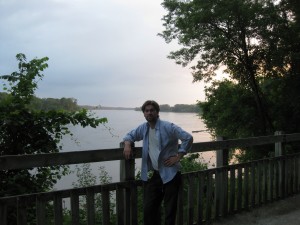We rose at 4 a.m. and left Buffalo in silence and darkness. We spent the entire day moving at top speed on interstates; we drove over a thousand miles in a single day. There is not much to report about a drive like this; as Steinbeck wrote, “with the completion of Interstate 80, it will now be possible to drive from New York to San Francisco without seeing a single thing.” We listened to music; we talked; we planned for the future.
But we did make one stop. Realizing that we had made excellent time zooming across Ohio, Indiana, and Illinois, and we were bound to arrive early in Kansas City, we found we had an hour to spare. I asked my companion Russ if there was anything in the area we could see. “Sure,” he said. “Why don’t you get off at the next exit.” The Missouri River was within a mile or two of the interstate. We drove down to Rocheport and found something – entirely by good fortune – called the “Katy Trail,” a bike trail running through central Missouri, and along this portion of its route paralleling the Missouri River. Its name was from the old railbed it ran atop of, of the Missouri-Kansas-Texas Railroad, the MKT or “Katy.” More than two hundred miles of the old line had been converted into a flat, quiet bike trail running conveniently between towns.
We asked a man who was standing near the trail entrance how we could get to the river, and he directed us east along its course. In the incipient darkness of sunset the trail looked subtropical and beautiful; spiderworts and dogbanes grew up under broad oaks and hickories. The Mississippi mulberries (Morus rubra) were in season and we sampled them by the handful. This is a terribly underrated fruit, very easy to grow, highly productive, and nourishing for animals as well as people. The trumpet creeper (Campsis radicans) was in bloom on the rock faces, and the whole place had an air of dank lushness and rank growth which suggested irrepressible exuberance. We skipped and ran down the trail: we were happy to be out of the car, happy to be with what was alive.
We came to a place where the trail ran along a bluff, opening up a view of the river. It was pouring down from the sunset, the river wide and the current strong. We thought immediately of Lewis and Clark paddling up its stream. “Can you imagine what it must have been like to have to paddle up this river? That’s a long paddle with more than a year’s worth of supplies.”
We had walked a good half-mile, and it was time to turn back and burn oil for Kansas City. We returned to the car, agreeing that we should come back. But we were headed west, where the river was coming from.


2 Comments